well hi there at last !
Apologies that this week`s cards of the day were sporadic in appearance, and backless, but I think I am getting to grips with this machine now. A bit. Sadly the one I used before was not recoverable, but it was of an age to only run Windows 7 and nothing lasts forever.
This one is Windows 10, but it has two keyboards, there is a small one to one side and a load of numbers to the other in a grid pattern. I am used to a full keyboard, so I keep getting numbers when I want a letter that was formerly over at the other side. And the " \ "symbol is where I used to capitalise things so there might be a lot of " \i " instead of " I " for a while. And then there is a key that shoots me off to the bottom of the document and that wasn`t what I wanted to do!
Anyway I am persistent so will "go with the flow and embrace the challenges". And please help me out by putting up with me whilst I do it. A few positive vibes through the ether wouldnt go amiss either....
as well as a spot of assistance, because I just had a crazy plan, that if these newsletters are to continue, lets all band together. I will put up what I have on Friday midnight as usual and work on them through the next day if I need to, and anyone who can supply the illustrations I cant, or the information I am missing can please just send them along to webmaster@card-world.co.uk
the newsletters are designed to be constantly updated and easily changeable, so lets start now. And anything that gets added later will be notified.

Today in 1911 Virginia Katherine McMath was born in Independence, Missouri. Independence was her mother`s watchword, and she lived it - she was on the run from her husband when she gave birth, would become one of the first female scriptwriters in Hollywood, and also became a Marine.
Virginia was a talented dancer, and she won a contest for which she got four weeks on tour. But by then her surname was Rogers, her mother having remarried. Nobody is really sure why she chose Ginger as a forename, maybe for her hair, as shown here, maybe for her spirit, though some say it was what a relative called her when they were too young to say Virginia.
She married for the first time in 1929 but it was not a great success, as is often the case when one or both are an independent being. It lasted just over two years. She married five times in all, and all ended in divorce - these included fellow star Lew Ayres, between 1934 and 1941, who is mentioned on the back of this card.
After the tour she had moved into films, as an extra, slowly getting more time on screen. In 1933 she appeared in Gold Diggers of 1933, 42nd Street, and Flying Down to Rio, where she had to dance with a partner. His name was Frederick Austerlitz, but luckily for stardom he had softened the first name and taken the surname of Astaire. She still made straight films, and won an Academy Award in 1940 for one, Kitty Foyle, but her cinematic partnership with Fred Astaire was what most people still remember her for . After leaving the movies, her last film was in 1965, she returned to Broadway and toured frequently. She died on April 25, 1995.
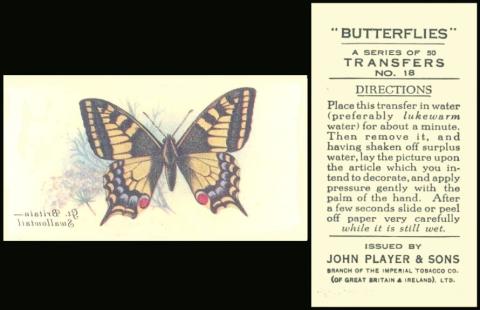
John Player [tobacco : UK] “Butterflies” – transfers (March 1932) /50 – P644-156.B : P72-74.B : P/37.B [RB.17/37.B]
Greetings to everyone out there with one or more tattoos, because today is National Tattoo Day, or National Ink Day to some.
Tattoos have been found on bodies that date from the time that man began, and primitive devices for inking feature in ancient carvings and works.
Both sexes seem to have been fond of showing off their tattoos in ancient Egypt, like a kind of status symbol. However in the Far East, they were thought of as something only the lower classes, or even the criminal underworld had, which is strange because many of the most popular designs these days are based on Chinese characters. Or maybe that is why!
Meanwhile, in several countries, they were a sign of your victories, much as we painted symbols on our Spitfires during the Second World War.
I wasn't sure tattoos existed on cards but they do if you expand the horizons, and forget your idea of only making them of ink. After all, before ink, people still marked their bodies, by carving the symbols, as you can see on Taddy "Natives of the World".
Another form are stickers, like Topps and O-Pee-Chee "Wacky Packages All New Series two Tattoos Stickers", a set of ten reversed images from 2005. And it is certain that our set might have seen service on someone's arm, etc., for though the text only mentions surfaces, the skin is surely the most fascinating of all surfaces on this Earth.
The best thing about a tattoo is also the worst, and that is its permanence. Symbols are easier to live with than a name unless you know you really love someone, and will do so forever. However there is a certain something about a tattoo, especially ones that are in hidden places and only eventually, and teasingly revealed. I like them, very much.
This transfer set is identical to the card set, but look, the words are in reverse, so that when you used the transfer and slid it off on to your skin it would be facing the right way up. It is recorded in our original reference book to the issues of John Player, RB.17, published in 1950, as :
37. BUTTERFLIES. Fronts in colour. Backs in grey. Home issue. March 1932, with special album.
- A. Small cards, backs with descriptive text
- B. Small transfers, backs with descriptions for use
This is slightly shortened in our original World Tobacco Issues Index, to :
BUTTERFLIES. Sm. Nd. (50) ... P72-74
- A. Cards
- B. Transfers. Special booklet issued.
The text in our updated version is exactly the same, but there is a new card code, of P644-156.
Now we feature the card version of this set as the Card of the Day for the 24th of March, 2025, so here we have space to deal with the booklet, which is only, curiously, mentioned in connection with the transfers and not within the heading, so I asked several collectors if they could shine a light my way.
When I saw it, the first thing I realised was that it is actually an album, but John Player themselves title it as "Player`s Transfer Book for a Series of 50 Transfers". However, and in many cases, it appears that the cards have been stuck in it, and not the transfers, which seems to support the theory that there was indeed no album produced to hold the cards - so now I wonder why not ? Any ideas ?
The other thing that I discovered from this "album" was that the title of the set is given there as "Butterflies - British and Foreign", though the back of both the cards and the transfers only give the title of "Butterflies". So was this the intended title, but it has been lost with the passage of time ?
Lastly, in that same title box, it also gives additional information, that these illustrations were "From original paintings of butterflies in the British Museum (Natural History), Sth Kensington". Now I cannot find these, and the only name that comes up is a Maria Sibylla Merian, whose paintings are in the British Museum proper, but none of whose works seem to be these.
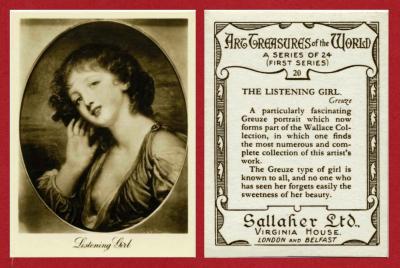
Shhh... It's World Listening Day today, so let's all sit comfortably and start to listen to our world.
There are quite a few thoughts behind the day.
The first is in taking time to hear what others are trying to tell you, so today don't just ignore them, or speak in their thinking spaces just let them unfold to you in their own time.
Another thought is to listen to nature, how peaceful it can be at some times and how noisy at others. You may live in a city with frequent traffic noise but if you really concentrate on the nature you will tune out the cars after a while.
Then there is listening to the radio, something that we have abandoned for the glamour of moving images, however why not go down the listing schedules online or on your TV and see if anything on the radio sounds interesting, then tune in and give it a go? Or music that you might not listen to normally, this is even easier, you just spin the dial on the radio and pick the next station that hums into earshot, you may hate it immediately, but you might find a new favourite station or style of music.
You'll never know if you don't try.
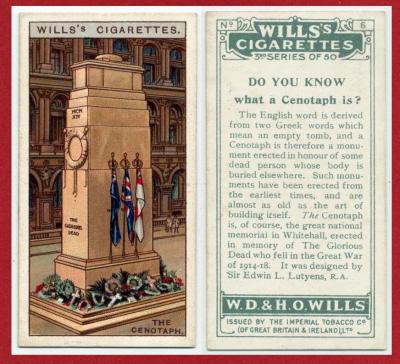
Today in 1919 was Peace Day, with commemorations and a lot of regret throughout our land. Of course there was regret and sadness in all lands, that's the way of War. But in our land, and specifically in London, we paid our tribute by way of an empty tomb set up along Whitehall, and this was known as The Cenotaph.
It was a temporary structure, right in the middle of a busy road, and made only of plasterboards, but it had some pedigree for all that, as it had been designed by the great Edwin Lutyens. It was primarily designed as a resting place for floral tributes, which would be delivered as part of a march by surviving service personnel. Yet people took it to their hearts, and a great cry was heard when it came time to dismantle it.
Of course it could not remain, for the plaster would disintegrate In rain and crumble in heat. The solution was to keep it, or more correctly make a replica, but construct this of solid stone. That would mean it would technically no longer be a Cenotaph, for that word means "empty hollow tomb", but it would be a Peace Memorial. However the people had the last word, again, and a hundred years on we still call it The Cenotaph.
Another one I may struggle with cards for, today is National Lollipop Day. So who out there can name a set that was issued with lollipops? I will look too...
Another kind of lollipop is brandished by the kindly folk who help schoolchildren across the road. They are a dying breed these days, nobody seems to have the time, and those that do might not fill all the stringent requirements of the DBS through no fault of their own, but at one time every school had them. I thought I might find one on a trade card but no luck yet. I then had a brainwave and thought of Wills "Safety First" but that was issued in 1934 so there was no use looking - because the first British lollipop lady, or "school crossing patrol officer" was a Mrs Hunt, who worked in Bath, and she only started her work in September 1937. If this sounds late, then think of this - in London it was not until the 1950s that the lollipop lady was seen at almost every school.
Today in 1997 great celebration was held to mark the heavy frigate U.S.S. Constitution, who had been afloat for two hundred years. And guess what, she is still afloat now! That makes her the oldest wooden ship to still be afloat.
She was indeed launched into the water in 1797. And she fought in many wars, including the 1812 war against us. This is where she earned the name "Old Ironsides", and crucially, her respect, for it is that which saved her many times when she was threatened to be pensioned off and destroyed. However she did not see action in the American Civil War, she was only used for training purposes. This also possibly saved her.
She was eventually retired from duty in 1881, but was given a new life as a museum in 1907. She still sailed the oceans, with a grand tour, of three years duration, in 1934. And was last seen sailing under her own efforts in 2012, the two hundredth anniversary of her most famous battle.
I would have thought there were loads of cards, but have so far only tracked down one, and that was not really a card, it is a package issue, where you cut the back panel section off the box and you got the "card". This was issued by Peco Candy Cigarettes in 1956 and is card one of their "Planes and Ships" series.
Someone else has emailed in and said that she also appears on a card issued by Sailor Boy Smokes in 1933, the set is called "Beautiful Ships" and she is card 10.
I have also been sent a link to the most amazing card which includes a piece of her body. This was issued by Topps, and you can read about it at the trading card database, which also does articles, something I never knew until I found this one.
None of this gets us a card I can show but there is one out there somewhere! If we keep hunting....
And so as our week comes to a close so does the first week of Archeologists Fortnight.
Traditionally the middle Friday of that fortnight is 'Ask an Archaeologist Day", which is not now done with people heading up to their local archaeological diggings for a quick Q and A session, but online, the ancient grasping the modern.
So let's see if we can answer some questions with cards. And if you have any questions about archaeological subjects please contact us at webmaster@card-world.co.uk - and we will try to find the answer on a card!
This week's Cards of the Day...
Saturday, 9th July 2022

the link here is Manchester City, which is the closest team to the birth place of Emmeline Goulden, in Moss Side. In fact their former ground, Maine Road, was built in the area in 1923 and they remained there until 2003.
She was born on Sloan Street, into a family of political activists, eventually being one of eleven children. There is some dispute as to whether her birthday was the 14th or the 15th of July 1858, but she grew up to claim the former, because it was Bastille Day, when those not in power stormed the building of those who were. She was not fond of her Christian name either, and preferred Emily, though came to realise Emmeline was much more grandiose.
She was fourteen when she attended her first public meeting on women's rights, and their demand to be allowed to vote.
Now we had this set listed as being by Soccer Bubble Gum, but we have been informed that it was actually issued by Merrysweets, "Soccer Bubble Gum" being one of their brands. There was a series one and a series two as well, each of forty-eight cards. And you can see all the cards in this first series courtesy of the Football Cartophilic Exchange / SBC1
Sunday, 10th July 2022

A year later, she was in Paris, going to school, a forward thinking one which taught chemistry to girls as well as more usual female pursuits like sewing. She shared a room with a girl whose father had been in prison for his political beliefs. This was probably more proof of her calling.
She turned down an offer of marriage, and believed she would never get married, but she did at the age of twenty, to a barrister who had also believed he would never get married. They met at a suffrage meeting, where he was fighting just as hard for the women`s cause as she was. It was strange and very attractive to her to find a man who cared about women and who thought they deserved their freedom. He was forty-four when they met, but the attraction was instant. However her family were not too happy, so much so that they thought they would not be allowed to marry and would have to live together. But her family were convinced, perhaps because being unmarried would have not allowed her to take any part in politics.
They were married just over a year since they first met, in December 1879.
Monday, 11th July 2022
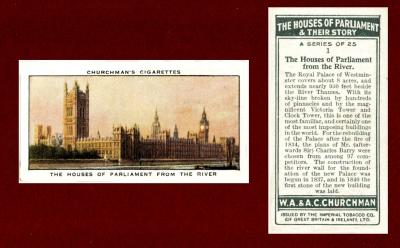
In 1903 Emmeline had founded The Women’s Social and Political Union (WSPU), a movement she would lead right the way through until its disbandment in 1918, growing ever more daring in its acts of rebellion.
In September 1908, along with her sister Christabel (also a Suffragette) and Flora Drummond decided to organise what was known as "a rush" on Parliament, storming it like the Bastille; specifically they aimed at the House of Commons which was thought to be more sympathetic, being closer to the working man than the House of Lords which was very aptly named. The planning took some time, but an enormous crowd of women gathered in Trafalgar Square on Sunday the 11th of October, incited by the fact that two days before the leading trio had been issued with summons after the police had been sent copies of the leaflet organising the rally. In fact police, in plain clothes, were at the rally too. This led to their arrest, and to them not being able to attend their "rush"; however sixty thousand people were there to take part, and many attempts to break into the House through the policemen who were protecting it in force. However they did not manage.
There is also another connection with this card, because in 1911 there was a major plan to disrupt the census. The idea was that women would either deface, or destroy the forms. Some went further, and Emily Davison actually hid in a broom cupboard within the Houses of Parliament. She remained there for forty-six hours, and then planned to record her place of residence as The Palace of Westminster. Her plan ended when she was found, by a cleaner, and arrested. She was released without charge, but her census still records that she was "found hiding in the Crypt of Westminster Hall, Westminster’.
If you look at the 1911 census, however, you will also find her at home, at her address in Coram Street; on the form which was filled in by her landlady.
And today there is a plaque, in her honour, in that cupboard.
Tuesday, 12th July 2022
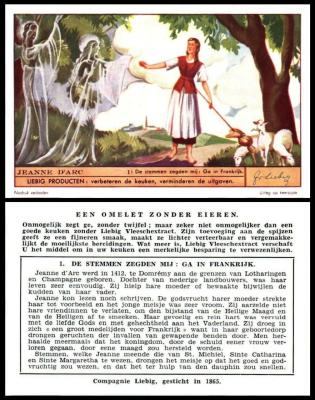
This card shows Joan of Arc, who was a symbol to many of the suffragette women and featured on many banners. Some even dressed as her in parades and demonstrations, and rode along with the foot soldiers. She was certainly a topical figure, for she had been beatified only recently. More than that, as our card shows, she was but a simple girl, who rose to the call, and conquered, even though she died, or more correctly, was killed in the attempt.
However there is a greater connection to Joan of Arc and the Suffragettes than some of you may know. This concerns Emily Davison Wilding, who was very enamoured with the Saint. One night in 1913 she had laid a wreath on a statue of her - and the very next day she travelled to the Derby. We will find out more about that tomorrow.
At her funeral banners were draped across her grave, which said 'Fight on and God will give Victory". These were Joan of Arc's last words, and had been requested as an epitaph by Emily Davison Wilding. However in the end this did not happen, and instead her grave bears a verse from the Bible, John 15:13 in the King James Version, "Greater love hath no man than this, that a man lay down his life for his friends."
Our card is the Dutch version of this set, and, sadly I know very little Dutch, but the title is "De stemmen zegden mij: Ga im Frankrijk". Luckily there is also a French version, which has the title of this card as "Les voix me disaient: Va en France", and that means "The Voices told me. They said : Go to France`. So our title must be the same, with "De stemmen" meaning the voices and "mij" being me. And of course "Frankrijk" must be France.
There was another Liebig set on Joan of Arc, but much earlier. That was issued in 1890, and it is actually the set I to our set II. It is called "Jungfrau von Orleans", this meaning "Young Woman of Orleans", and it has German text. The codes on that are Fada F.269 and Sanguinetti S.270.
Strangely this earlier set has a single, more religious figure speaking to her, closely resembling an angel, whereas our set they look more like ghosts. Not sure why that should be.
And there is another fact which you might not be aware of, and that is when this first set was issued Joan of Arc was not a Saint. She may have been declared a martyr, very early on, in 1456, but it was only in 1909 that she was beatified, which means that the Church admitted she was in Heaven, and able to hear your prayers. However her sainthood was only granted in 1920, by Pope Benedict XV.
Wednesday, 13th July 2022

So here we have the fateful day for Emily Davison, the Derby, 1913. And the event is recorded, very matter of factly, on the back of this card, where it says that : "At Tattenham Corner a woman rushed on to the course and sustained fatal injuries".
This woman was Emily Davison. We are still not entirely sure what she was doing, but recently several facts have come to light and it has been presumed that she was attempting to catch hold of this horse , Anmer, belonging to His Majesty The King. However something went wrong, bringing her, the horse, and the jockey, Herbert Jones, crashing to the floor. She died four days later, having never regained consciousness. Herbert Jones was also injured, being concussed, and losing consciousness temporarily. He must also have broken his arm, because he wore a sling for a while, though he did ride at Royal Ascot a fortnight later, and he rode Anmer.
There seems no hard feelings from the suffragettes, and he was invited to the funeral of Emily Davison, but did not feel well enough. However he must have regretted that, because later he attended the funeral of Emmeline Pankhurst, and even laid a wreath.
There are many theories as to Emily Davison`s intentions. Some say she wanted to be a martyr. Some say that she was hoping to attach a Suffragette flag, or banner to the horse, or put it around his neck, so that when he was photographed in the press the message would be forever visible. She had a return ticket amongst her possessions, and recently it was discovered that a banner was given to a steward after the race.
In addition, both her and her mother were frequently observed in London`s Hyde Park attempting to catch hold of horses, which afterwards was realised was them practising for the "big day". This makes it even more likely that the accident was caused simply because they did not realise that a racehorse, at gallop, was a far faster animal than a riding horse, which usually was held at canter.
This set is very attractive but the white background is very prone to dirt. It is recorded in our original John Player reference book, RB.17, published in 1950, as
70. 50. DERBY & GRAND NATIONAL WINNERS. Small cards. Fronts in colour. Backs in grey. Home issue. April 1933
A. Small cards, Backs with descriptive text.
B. Small transfers, backs with inscriptions for use.
Colour variations occur at No. 7 - cap in (a) yellow (b) blue and green (c) green
Our World Tobacco Issues Indexes do not mention this colour change, they both simply say
DERBY & GRAND NATIONAL WINNERS. Sm. Nd. (50)
A. Cards
B. Transfers
Thursday, 14th July 2022
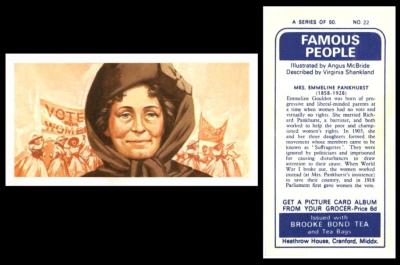
This is a very popular set and deservedly so.
It appears in our original British Trade Index part III as
Famous People . Nd. (50)
A. Back in blue, issued 1969.
B. Back in black, issued 1973.
And it just squeezes in to our updated volume, where it is described as
FAMOUS PEOPLE. 1969. Nd. (50). Blue back. Reissued 1973, black back
Now if you look closely at this card the backdrop shows women, marching with their "Votes for Women" banners held high.
There was a wallchart and an album to hold the collection. I know little about the wallchart, but the album is intriguing as it had several versions. The original credits "Berkshire Printing" inside the back cover, and has two different order forms (see Brooke Bond Collectables/FP) - whilst the reprint can be found with or without a price on the cover, and with or without the printer`s name.
A similar picture to the backdrop on this card appears on card 38 of the later, 1983 issued, Brooke Bond set of "Queen Elizabeth I - Queen Elizabeth II", but without Mrs. Pankhurst in the foreground. That text tells us that "In 1918 women over 30 were given the vote ... voting equality with men was established in 1928 just before Mrs. Pankhurst`s death."
This is actually slightly incorrect, because Mrs. Pankhurst died on June the 14th 1928, and the Representation of the People (Equal Franchise) Act 1928 was not given Royal Assent until the 2nd of July 1928 - just after her death.
Friday, 15th July 2022
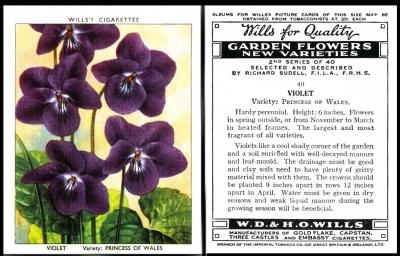
Violets were a major emblem to the Suffragettes, and each one who was unlucky enough to go to prison would be met with her fellow workers as she left and given a posy of the flowers.
They were also, interestingly, formed of the same three colours that symbolised the WSPU - green, white and purple - colours which were incorporated into many other ways of protest for those not brave enough to carry a banner, or state their true belief. This also applied to jewellery, where the three colours were peridot for the green, pearl for the white, and amethyst for the purple.
And many of the suffragettes changed their name to Violet, or added it, whether openly or secretly, as a middle name.
There were other connections too. The editor of the Suffragettes weekly newspaper "Votes For Women" explained them as : "Purple as everyone knows is the royal colour, it stands for the royal blood that flows in the veins of every suffragette, the instinct of freedom and dignity...white stands for purity in private and public life...green is the colour of hope and the emblem of spring.'.
Whilst in the most basic language of all, the initials of Green White and Purple also stood for Give Women Votes.
well we made it, thanks to our trusty tablet, which is also a vintage version, but then you knew that. Doing it wasn't so bad, and next week it will be better!
Have a great week, and use this as a chance to also try to look at every challenge as an opportunity. There is a lot of negative or even toxic things out there, but there are also lots of good things. The problem is that people talk more about the bad than the good so everything seems bad; if we talked more about the happy, then maybe it would overcome.....
Or is that a way too simplistic view.
See you all next week - and please keep in touch with all your card news and views to keep this site alive with happenings.
